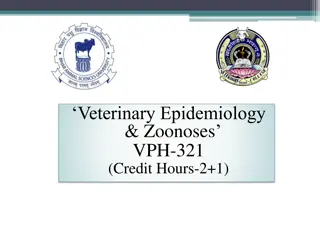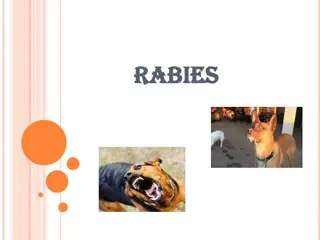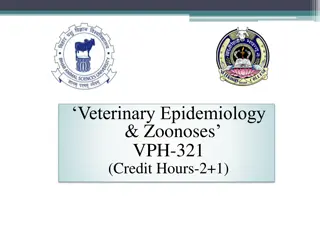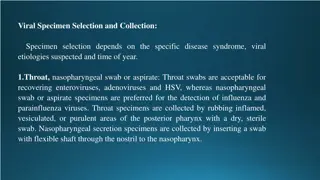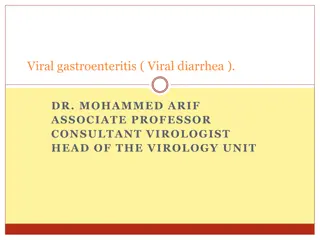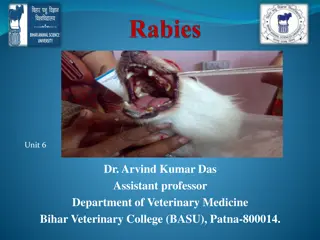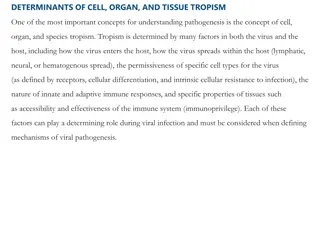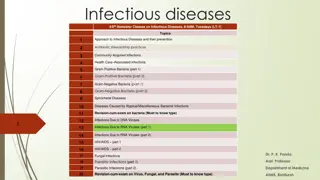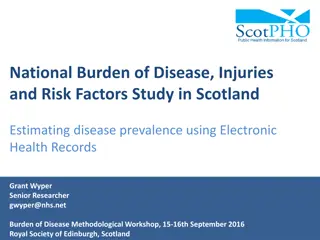Rabies: A Fatal Viral Disease and Its Global Impact
Rabies, also known as hydrophobia, is a highly fatal viral disease that affects humans and other mammals through transmission from infected animals. Originating in ancient times, rabies has a significant global burden, with a high mortality rate in Asia and Africa. The disease is endemic in India, with a substantial number of deaths reported annually, especially among children. Louis Pasteur's discovery of the rabies vaccine in 1890 marked a significant milestone in combating this deadly disease.
Download Presentation

Please find below an Image/Link to download the presentation.
The content on the website is provided AS IS for your information and personal use only. It may not be sold, licensed, or shared on other websites without obtaining consent from the author.If you encounter any issues during the download, it is possible that the publisher has removed the file from their server.
You are allowed to download the files provided on this website for personal or commercial use, subject to the condition that they are used lawfully. All files are the property of their respective owners.
The content on the website is provided AS IS for your information and personal use only. It may not be sold, licensed, or shared on other websites without obtaining consent from the author.
E N D
Presentation Transcript
Rabies, also known as hydrophobia, is a highly fatal viral disease that causes inflammation of the brain in humans and other mammals. It is caused by Lyssavirus type 1. Transmission of Rabies to human- Bites (95%), Scratches & Licks from infected animals.
It is a zoonotic disease of warm blooded animals such as Dogs, Skunk, Cats, Jackals, bats and wolves.
History of Rabies Man described the disease in 2300 B.C. The word Rabies originated from rabhas , meaning to do violence . It comes from ancient Indian Sanskrit dating 3000 B.C. Since Roman times, man established between the infectivity of a rabid dogs saliva and the spread of the disease. Because there is no cure, those that had been bitten by a rabid dog would commonly commit suicide to avoid the painful death that would inevitably follow. the link
Louis Pasteur (a French biologist, microbiologist and chemist) was thefirst person to diagnose that rabies targets the Central Nervous System (CNS) In 1890 created the rabies vaccine and saved 9 year old Joseph Meister after he had been bit by a rabid dog
Global Burden A very wide distribution-Human rabies is present in 150 countries and territories and on all continents, except for Antarctica.
Globally: estimates mortality is highest in Asia, with the highest incidence and deaths reported in India, followed by Africa. The virus claims an estimated of 59,000 (95% confidence intervals (CI):25 1,59,000) human lives annually, mostly in Africa and Asia. Over 95% of rabies deaths in humans result from virus transmission through the bites of infected dogs indicate that human Source: Human rabies: 2016 updates and call for data, Weekly epidemiological record Authors: WHO/ Department of Control of Neglected Tropical Diseases
Burden in India India is endemic for rabies accounting for 36% of the world s deaths. True burden of rabies in India is not fully known; although as per available information, it causes 18,000 - 20,000 deaths every year. 30%-60% (approx) of reported rabies cases and deaths in India occur in children under the age of 15 years Source: WHO, India, http://www.searo.who.int/india/topics/rabies/en/
Why Children are at more risk in India? Children are more likely to pat and play withanimals. Less likely to let an adult know if an animal has bitten them More likely to get severe bites to their heads, face and hands. https://www.babycenter.in/a1023804/rabies-in-babies-and-children#ixzz5JaYU1Pcp
Burden of Rabies- Statewise Rabies deaths are widely distributed throughout thecountry Source: Suraweera, Wilson & Morris, Shaun & Kumar, Raj & A Warrell, David & Warrell, Mary & Jha, Prabhat. (2012). Deaths from Symptomatically Identifiable Furious Rabies in India: A Nationally Representative Mortality Survey. PLoS neglectedtropical diseases. 6. e1847. 10.1371/journal.pntd.0001847.
Reports & Study findings on Rabies inIndia 1. 2. 3. 4. 5. MCCD - Medically Certified Causes of Death, Annual Report SCS - Survey of Cause of Death MDS - Million DeathStudy RGI - Registrar General of India Re-evaluating the burden of rabies in Africa and Asia. Knobel DL, Cleaveland S, Coleman PG, F vre EM, Meltzer MI, Miranda ME, Shaw A, Zinsstag J, Meslin FX Bull World Health Organ. 2005 May; 83(5):360-8. Government hospital data from the routine data collection of the Union Ministry of Health and Family Welfare 6.
AGENT Rhabdovirus Lyssavirus type 1 Bullet shaped virus Size is 180 *75nm Has a lipoprotein envelope Knob like spikes or glycoproteinG. Matrix protein layer Genome unsegmented ,linear, negative sense RNA.
TYPES OF RABIES VIRUS STREET VIRUS FIXED VIRUS The virus recovered from naturally occurring cases of rabies is called street virus. The virus which has a short , fixed and reproducible incubation period is called fixed virus. SOURCES It is naturally occurring virus . It is found in saliva of infected animal It is prepared by repeated culture in brain of rabbit such that its IP is reducedand fixed. FEATURES 1. It produce negribodies 2. Incubation period is 20 to 60 days. 3. It is pathogenic forall mammals 4. Cannot be used for preparation ofvaccine 1. 2. It does not form negribodies Incubation period is constant between 4-6 days. It can be pathogenicfor humans under certain conditions. It is used to prepare anti- rabies vaccine. 3. 4.
RESERVIOUR OF INFECTION URBAN RABIES: 1. 99% cases in India is from dogs and cats. 2. A single infected dog capable of transmitting over an area of 40 km. WILD LIFE RABIES : 1. sylvatic rabies 2. Unidentified reservoir of infection 3. Foxes, jackals, hyenas , skunksetc. 4. Transmit infection among themselves and to dogs andman.
BATRABIES: 1. Latin American countries ,USA 2. Vampire bats feed on blood of humans and animals. 3. Cause havoc to cattle population 4. Not reported in India 5. Constant sources of infection to man and animals 6. Transmission by bite and aerosols.
HOST FACTORS All warm blooded animals including man. Rabies in man is a dead end infection People at risk-lab workers, veterinarians, dog handlers , hunters etc
INCUBATIONPERIOD Normally 3-8 weeks Maybe short that is 4 days or maybe prolonged for years. Depends on site of bite Severity of bite Number of wounds Amount of virus injected Species of biting animal Protection provided by clothing Treatment taken or not.
Know as hydrophobia (fear of water) Duration of disease: 2-3 days prolonged to 5-6 days (exceptional cases) Prodromal symptoms (3-4 days) Headache Malaise Sore throat slight fever Followed by excitation and stimulation off all parts ofnervous system Sensory system Nervous system Motor system Sympathetic system Mental system
Patient becomes intolerant to noise, bright light, cold draught ofair (sensory). Aerophobia (fear of air ) may be present. Increased reflexes and muscle spasms(motor). Dilatation of pupil and increased perspiration , salivation, lacrimation.(sympathetic). Fear of death , irritability , anger and depression (mentalchanges). Patient dies abruptly due to convulsions or pass to comaand paralysis.
DIAGNOSIS On basis of clinical history of bite by rabidanimal Characteristic signs and symptoms Confirmatory tests Antigen detection by immunofluroscence (skinbiopsy). Virus isolation (saliva and other secretions) Immunofluroscence of corneal impression smears proven unreliable.
TREATMENT No specific treatment Case management Isolation in a quiet room protected as far as possiblefrom external stimuli to prevent spasms and convulsions Relieve anxiety and pain by use of sedatives Morphia 30-54mg If spastic muscle contractions present use drugs withcurare like action Ensure hydration and diuresis Intensive therapy in the form of respiratory andcardiac support
Patients with rabies are highly infectious virus is present inall secretions like saliva , tears, vomits, urine, and other body fluids. Nursing personnel should be warned of risks and protect themselves with PPE Persons with open wounds and cut should not attend the patients In places where rabies cases are encountered frequentlypre exposure prophylaxis (2-3 doses HDC vaccine ) recommended.
PREVENTION OF HUMAN RABIES This may be considered under 3 heads Post-exposure prophylaxis. Pre-exposure prophylaxis. Post-exposure treatment of persons who have been vaccinated previously
POST-EXPOSURE PROPHYLAXI 1. General consideration 2. Local treatment of wound (a) Cleansing (b) Chemicaltreatment (c) Suturing (d) Antibiotics and anti-tetanus measure 3. Immunization
Immunization Rabies vaccines prequalified by WHO do not contain preservatives such as thimerosal. The shelf-life 3 years Stored at +2 C to +8 C and protected from sunlight. Following reconstitution with the accompanying sterile diluents, the vaccines should be used immediately, or within 6-8 hours if kept at the correct temperature. All CCEEVs should comply >=2.5 IU persingle intramuscular dose .
Categories of contact and recommended post-exposure prophylaxis (PEP) Categories of contact with suspectrabid animal Post-exposure prophylaxis measures Category I - Touching or feeding animals, licks on intact skin None Category II - Nibbling of uncovered skin, minor scratches or abrasions without bleeding Immediate vaccination and local treatment of the wound Category III - Single or multiple transdermal bites or scratches, licks on broken skin; contamination of mucous membrane with saliva from licks, contacts with bats. Immediate vaccination and administration of rabies immunoglobulin; local treatment of the wound
All category II and III exposures assessed as carrying a risk of developing rabies require PEP This risk is increased if : The biting mammal is a known rabies reservoir or vector species The animal looks sick or has an abnormal behaviouR A wound or mucous membrane was contaminated by the animal's saliva The bite was unprovoked The animal has not been vaccinated And if biting animal cannot be traced or identified.
Intramuscular administration of vaccine for post-exposure prophylaxis Essen regimen : The 5-dose regimen prescribes 1dose on each of days 0, 3, 7, 14, and 28 Dose: one IM dose (1.0 or 0.5 ml) into deltoid (or thigh) 28 Day : 0 3 7 14 Rabies immunoglobulin
Zareb regimen: The 4-dose abbreviated multisite regimen prescribes 2 doses on day 0 (1 in each of the 2 deltoid or thigh sites) followed by 1 dose on each of days 7 and 21, as shown below. Dose : one IM dose (LO or 0.5 ml) into deltoid (orthigh) 21 Xl Day: Sites X2 0 7 Xl
Intradermal administration for post- exposure prophylaxis The 2-site regimen prescribes injection of 0 .1 ml at 2 sites (deltoid or thigh) on days 0, 3, 7 and 28. The day 14 dose is missed 2-site intradermal regimen (2+2+2+0+2) Dose : one JD dose one fifth of IM dose (0.1 ml) ID per site 28 X2 3 X2 7 X2 Day Sites X2 0
Post-exposure prophylaxis for previously vaccinated individuals For rabies-exposed patients who can document previous complete pre-exposure vaccination or complete post exposure prophylaxis with a CCEEV, 1 dose delivered intramuscularly or a CVV delivered intradermally on days 0 and 3 is sufficient
Immunization of immunocompromised individuals In immunocompromised individuals including patients with HIV/AIDS, a complete series of 5 doses of intramuscular CCEEV in combination with comprehensive wound management and local infiltration with human rabies immunoglobulin is required for patients with category II and III exposures.
Pre-exposure prophylaxis IM or 0.1 ml ID on days 0, 7 and either day 21 or 28. For clinicians and persons attending to human rabies cases, veterinarians, animal handlers
Adverse events following immunization In general, CCEEVs have been shown to be safe and well tolerated. However, in 35-45% of vaccines, minor and transient erythematic, pain and/or swelling may occur at the site of injection, particularly following intradermal administration of a booster. Mild systemic adverse events following immunization (AEFI), such as transient fever, headache, dizziness and gastrointestinal symptoms, have been observed in 5-15 % of vaccines
RABIES IN DOGS INCUBATION PERIOD : Ranges from 3-8 weeks but it may be as short as 10 days or as long as 1 year. CLINICAL PICTURE: It manifest in 2 forms : Furious rabies and dumb rabies. FURIOUS RABIES : Typical mad- dog syndrome.
CHANGE IN BEHAVIOUR- Loses its fear of people , aggressive, bites unusual objects- stick , straw and mud. RUNNING AMUCK: Tendency to run away from home and wander. CHANGE IN VOICE: Barks and growls in a hoarse voice or unable to bark EXCESSIVE SALIVATION: Foaming at the angle of mouth PARALYTIC STAGE: Later stage paralysis of the whole body leading to coma and death.
DUMB RABIES: Exciting and irritating stage is lacking. Its predominantly paralytic. Dog withdraws from being seen and disturbed. Dies in about 3 days. LAB DIAGNOSIS : FLUROSCENT ANTIBODY TEST: Highly reliable and best single test for rabies antigen detection. If brain is negative by FRA test , person need not be treated. MICROSCOPIC EXAINATION: Negri bodies identifies 75-90% of cases.
MOUSE INOCCULATION TEST : Intracerebral mouse inoculation of the infected brain tissue show signs of rabies between 6-8 days if infected. CORNEAL TEST: Antigen detection in corneal impressions or in frozen skin biopsies by FRA. CONTROL MEASURES IMMUNIZATION OF DOGS: Mass vaccination of dog. All dog must receive Primary immunization 3,4 months and booster dose at regular interval. BPL inactivated nervous tissue vaccine: Revaccination done after 6 month and every year subsequently Modified live virus vaccine: Booster every 3 years.
CONTROL OF URBAN RABIES Cost effective approach is the elimination of stray dogs and ownerless dogs combined with mass immunization at least 80% of the area. Registration and licensing of all domesticdogs Restrainin public places. Immediate destructions of dogs and cats bitten by rabidanimals. Quarantine for 6 month of importeddogs. Health education ORAL VACCINE: For the immunization offoxes.





